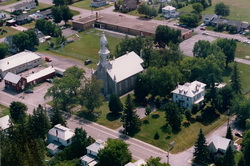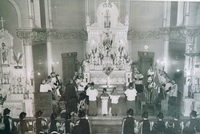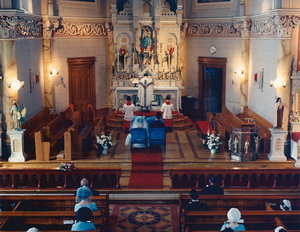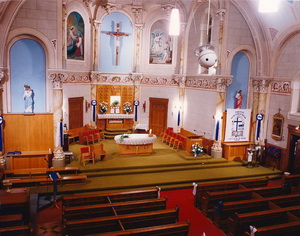HISTORICAL SKETCH OF CRYSLER'S OUR LADY OF THE ROSARY PARISH
Geographic Location and Village History:
The Village of Crysler is located in Finch Township, at the north-west corner of Stormont County in Eastern Ontario. The South Nation River which meanders through the fertile fields of the region is very likely what prompted the pioneers to settle in the area. The village gets its name from John Pliny Crysler. He came to settle in Crysler in 1865 with his wife Sarah H., whose maiden name is not known. He was the son of the famous Colonel John Crysler, who in 1779, at the age of 12, was the drummer boy at the battle of Buttler's Rangers. As a reward for his loyalty to England he was granted 60,000 acres of land. He was also Colonel of the militia during the battle of Crysler's Farm on November 11, 1813.
His land grant stretched from the St. Lawrence River to Crysler. His son Ralph inherited lot 12, concession 10, which is where Crysler is now located.
In those days, the local economy was driven by the logging industry. The forest was a rich natural resource providing winter work for settlers. In spring the log drives were an economical way of transporting timber to large urban centres. Log drivers would float the logs on the South Nation River from Crysler to the Ottawa River and then on to Bytown, the biggest market for wood.
The first dam was constructed in 1808 and rebuilt out of wood in 1895.
John Pliny Crysler built a flour mill which was powered by water falling over a large paddle wheel.
A bridge built in 1885 in Crysler linked the two banks of the South Nation River for the first time. This early bridge was destroyed by the spring flood of 1886 and was replaced by a steel bridge in 1890.
More and more settlers came to Crysler. The newcomers were predominantly anglophone of Irish and Scottish descent. These were later joined by a number of francophone settlers, some from Embrun, but most from the Montreal area. The anglophones lived on the north bank, while the francophones settled the south shore.
In order to accommodate all members of the community, Mr. Crysler donated parcels of land for three churches, one Catholic, one Anglican and one Presbyterian.
Our Lady of the Rosary Parish:
The history of this parish goes back to 1870. In the beginning it was called St. Mary's Mission of St. Andrew's Parish in Cornwall Township, Diocese of Kingston. It was known by this name until 1873 when it became the Mission of Finch and Roxborough. The name Our Lady of the Rosary came later still.
The construction of the Catholic church started in 1868. The structure was a mere 40 feet by 60 feet (12.2 X 18.3 metres) and took six years to be completed. A small altar and sixty pews were installed during the advent of our first parish priest, Reverend Thomas Sprat. The date inscribed on the cornerstone is May 4, 1870. The first Mass was celebrated September 22, 1870. The parish consisted of thirty-three French, Irish and Scottish families.
Father Sprat stayed for only one year and was replaced by the Reverend Charles Duffus on July 16, 1874. Father Duffus obtained a building lot just north of the church and built a brick presbytery. When he left on June 24, 1879, the presbytery was almost completely paid off. At this time, a cemetery was established behind the church.
Reverend William M. Fox bought a new church bell. It was blessed and baptized Mary Catherine. He also renovated the altar.
The first episcopal visit took place in 1882 and the second in 1885. On the second visit by the Bishop of Kingston, the Most Reverend James Vincent Cleary, 221 parishioners were confirmed. The Bishop spoke first in English and then delivered a sermon in French. On this occasion he also ordered the construction of a new church. The original church did not have a firm foundation and the walls seemed dangerously unstable. Fearing for the safety of the parishioners, he strongly urged that quick action be taken.
Father John Towney was named parish priest for the years 1889-1891. On August 1, 1889, it was announced that the parish was now part of the Alexandria Diocese which included Stormont and Glengarry counties.
A new cemetery was established on Lafreniere (Swale) Road and was blessed in September, 1896. Angelina Godard, daughter of Joseph Godard and Louise Chartrand was the first to be buried in this cemetery. Father William McKinnon was the parish priest at the time.
The Way of the Cross was set up in the old church on October 1, 1898.
The cornerstone of the new church was blessed and laid on July 11, 1899. Inside it were placed an historical record of the event, copies of newspapers of the time, several coins, and engravings of the Bishop, His Lordship Right Reverend Alexander Macdonnell. The Service held on Sunday September 10, 1899, was the last held in the old church, as the work of removal began the following day.
Until the new church was ready, a temporary chapel in the Sacristy basement was used for the celebration of Mass, baptisms, weddings and funerals.
The first Mass celebrated in the new church proper was that of Easter on April 15, 1900. The new church was officially blessed on May 1, 1900. The first marriage celebrated in the new church proper was that of John Beehler and Bridget Anastasia McCadden on April 30, 1900. The first to be baptized there was Joseph Ernest Omega Hebert on May 6,1900. The first funeral was held on July 27, 1900 for Rosalba Dubois, wife of Theophile Lapalme. Father Donald R. Macdonald was the parish priest at the time of the construction and inauguration of the new church; he was pastor from 1898 to 1906.
The church was, for the first time, lighted by electricity on the evening of Christmas, December 25, 1905. This was the inauguration of the use of electric light in Crysler. Joseph Bishop and Son had established a lighting plant in their new flour mill.
Father Terence Fitzpatrick stayed in Crysler for one year from 1906 to 1907. His successor, Father Michael J. Leahy came to Crysler in 1907 and remained for twenty-four years, until 1931. His parishioners held him in great esteem and he is even buried in the parish cemetery.
Father J. Henri Bougie served the parish from 1931 to 1944, followed by Father J. Albert Goulet from 1944 to 1954. Parish priests were staying for longer periods which added stability to the parish
By 1954 the church was in need of renovation. Father Bernard Guindon had the ceiling repaired. Paintings were added as well as an automatic oil furnace.
On May 26, 1960, the Bishop of Alexandria, the Most Reverend Rosario Brodeur, presided over the consecration of the church. Authentic relics of St. Paul and St. Philip Neri were placed in a silver chest along with documents attesting the authenticity of the relics, the official record of the consecration of the church and a few medals and coins. The chest was sealed in the sepulchre of the main altar.
In 1962 Mrs. Herman Lehoux gave Father Rheal Gagnon, the parish priest at the time, the idea of converting the sacristy into a funeral parlour. This would make life easier for the people of Crysler by providing them this service in their own village. Sadly, the first person to be waked in Crysler was Mrs. Lehoux's own husband.
In 1963 Father Rheal Gagnon also decided to make some renovations to the inside of the church. The main altar and the side altars, dating back to the beginning of the century, were replaced by altars made of natural wood. The organ was installed in the front of the church and the Mass which up until then had been sung in Latin now began to be said in English and French.
A further addition was a large illuminated cross in front and to the right of the present church to commemorate the site of the first church. The cemetery behind the church was closed down and the land was loaned to Notre-Dame-du- Saint- Rosaire school.
Father Gagnon had a dynamic personality. He helped organize the first Winter Carnival, loved to participate in cultural activities and even wrote plays.
Father Bernard Guindon returned for five more years, until 1975. Then Father Roger Desrosiers served as parish priest from 1975 to 1977. Father Fernand Brazeau, C.S. V., then took over until his death in 1980.
Father J. Roch Bougie, C.S.V., be- came our Pastor in 1980 and remained until 1993. Father Bougie loved maple syrup season. With the help of several volunteers, he collected sap from a number of local maple trees. Having produced a fair amount of maple syrup, he decided to organize a sugar bush brunch in the spring. He provided the maple syrup while volunteers prepared the meal. This activity not only added considerably to the church coffers, but also provided a fine opportunity for people to gather for a happy event.
Father Claude G. Thibault served the parish from 1993 to 1999. Father Thibault, a young and active priest, became very involved with his parishioners whom he inspired in many ways to participate in the life of the parish. His exuberance and joy of living were infectious. He worked on preparing the events for the 125th anniversary of the parish, one of those being a special Mass which was televised on Radio-Canada (CBC) last February. Father Thibault commenced the activities needed to embark on a very important event: the renovation of the church.
Since 1999, Father Marc Piché has been our pastor. Father Piché, another young and active priest, is actively involved with many parish activities. In 2000, Father Piché took to completion the renovation project commenced by Father Thibault. During the summer of 2000, the parishioners met in the gymnasium of the village school. On Saturday September 16th 2000 we celebrated the first mass in the newly renovated church and on October 7th 2000 the Bishop, the Most Reverend P. LaRoque, presided over the official inauguration of the renovated church.
Schools and the Arrival of the Holy Cross Sisters:
A log structure built in January 1876 behind the Catholic church was Crysler's first Catholic separate school.
In 1922 a new school was built to accommodate 101 students. This one was larger, containing four classrooms and two corridors. It opened at the same time as the Sisters moved into our community. On an invitation from The Crysler School Board, the Holy Cross Sisters came to take over the teaching at the Catholic school. They arrived on August 29, 1922 and took up temporary residence in the presbytery while their convent was being built. They moved into their new home on September 2, 1922.
The village school was destroyed by fire on March 1, 1941. It was rebuilt immediately through the generosity of the Ministry and the taxpayers. This third school was very up to date, with electricity, central heating and a good ventilation system. It was ready to accept students on December 9,1941. The school we have today was built in 1959-1960. It was very avant-garde for its time since it had a gymnasium, a kindergarten as well as other facilities for teachers and the principal. An addition was built in 1965 and the old two story schoolhouse was torn down in 1966, providing more room in the school yard for the students. From 1924 until 1967 even grades 9 and 10 were taught in the parish school.
Because of decreasing numbers in their order, the Holy Cross Sisters decided to leave the parish. Despite the many protests from the members of the parish and various community groups, they moved out at the end of June 1967.
Today 205 students attend the Crysler school.
The Village and the Community Today:
Crysler village, well known for its famous floods of 1907, 1938, 1950 and 1976, now has a dike along the south side of the South Nation River and around the buildings east of Queen Street. The dike was built in 1984 and since then the spring floods have had no severe effect on the village.
The bridge built in 1890 was replaced by a steel structure in 1935 and again in 1975 by a structure supported by concrete piers.
The number of businesses in the village has significantly decreased with one closing after another for various
reasons. Most often, businesses burned down and were never rebuilt. In some cases outside companies bought out existing businesses to cut down on competition. As the number of businesses decreased so did the number of jobs available in Crysler and people were forced to look for work in other locations. Several members of the business community, however, have loyally remained at their post. We wish them continued success for many years to come.
Quicker and more efficient means of transportation have made it easier for people to commute to work outside the area. As a result, we are tending to become a bedroom community for the city of Ottawa.
At one time there were many small farms of 80 to l00 acres. Most of these have gradually been sold to larger agricultural enterprises. In an area that was once almost entirely dependent on farming, the proportion of farmers among the population has dramatically decreased.
The 80% predominantly francophone majority and the anglophones get along very well in a climate of good will and mutual respect.
Crysler is now in the process of creating a new image. A new water and sewage system is installed in the village bringing with it the possibility of economic renewal. An apartment block for seniors has been built and we look forward to the emergence of new businesses that will provide employment for our young people.
We are now well into the new millennium. What does the future hold in store for us? We have celebrated more than 125 wonderful years of history. A fine heritage. Now it's up to us to make sure that it's only the beginning.
August, 1995 & Mai 2001
This text was written by Denise Bourdeau (and translated by Bianca Sherwood) using the following references:
Crysler par Gilberte Farley, Diane Legault, Thérèse Papineau et Carole Prévost;
Ebauche de l'historique de la paroisse, Juliette Champagne ;
L'Histoire de Crysler par Mme Rosa Lafrance;
Les soeurs de Sainte-Croix dans la montée avec les franco-ontariens, Hélène Bériault,c.s.c. ;
Pioneer History of Finch Townships, Teachers of Finch Township;






